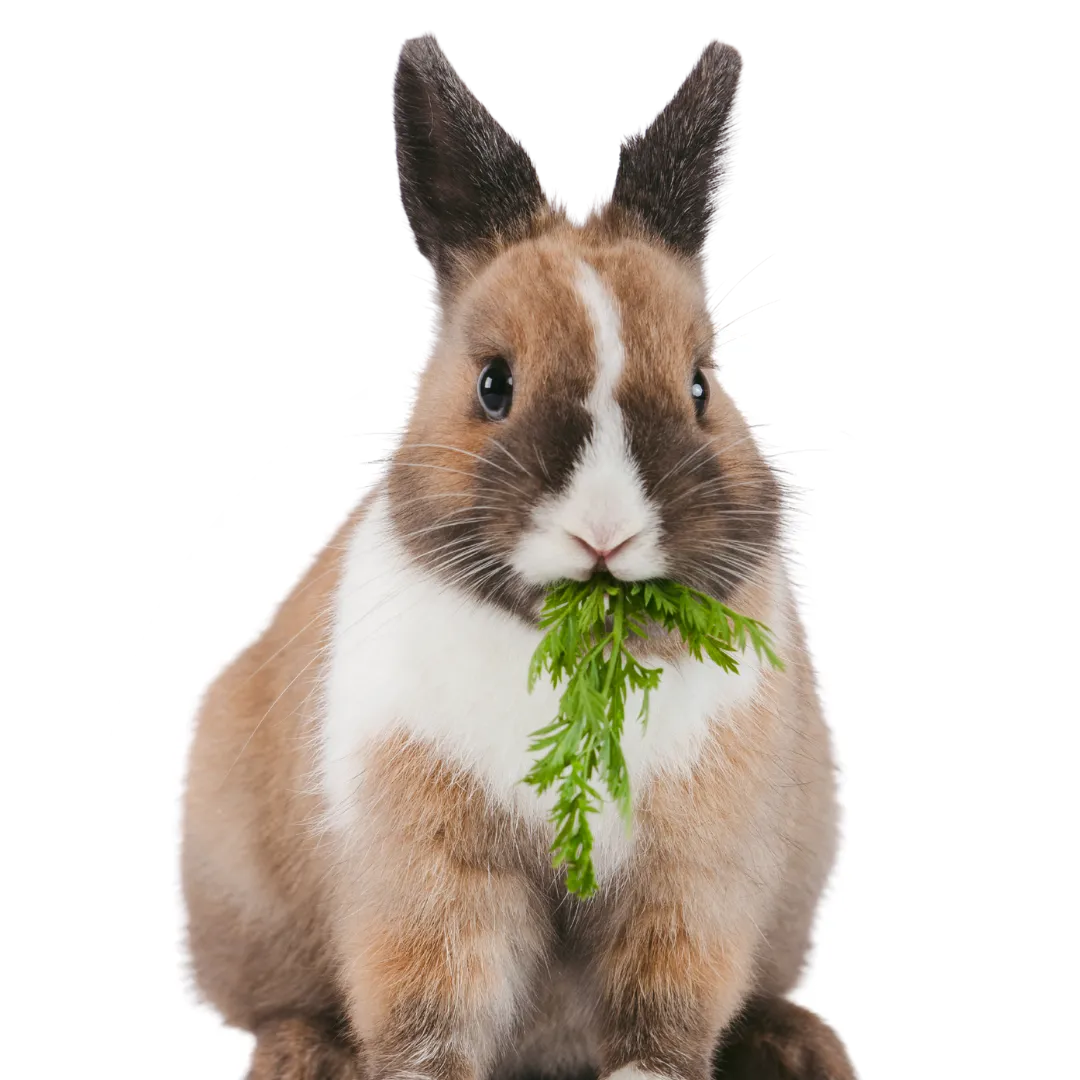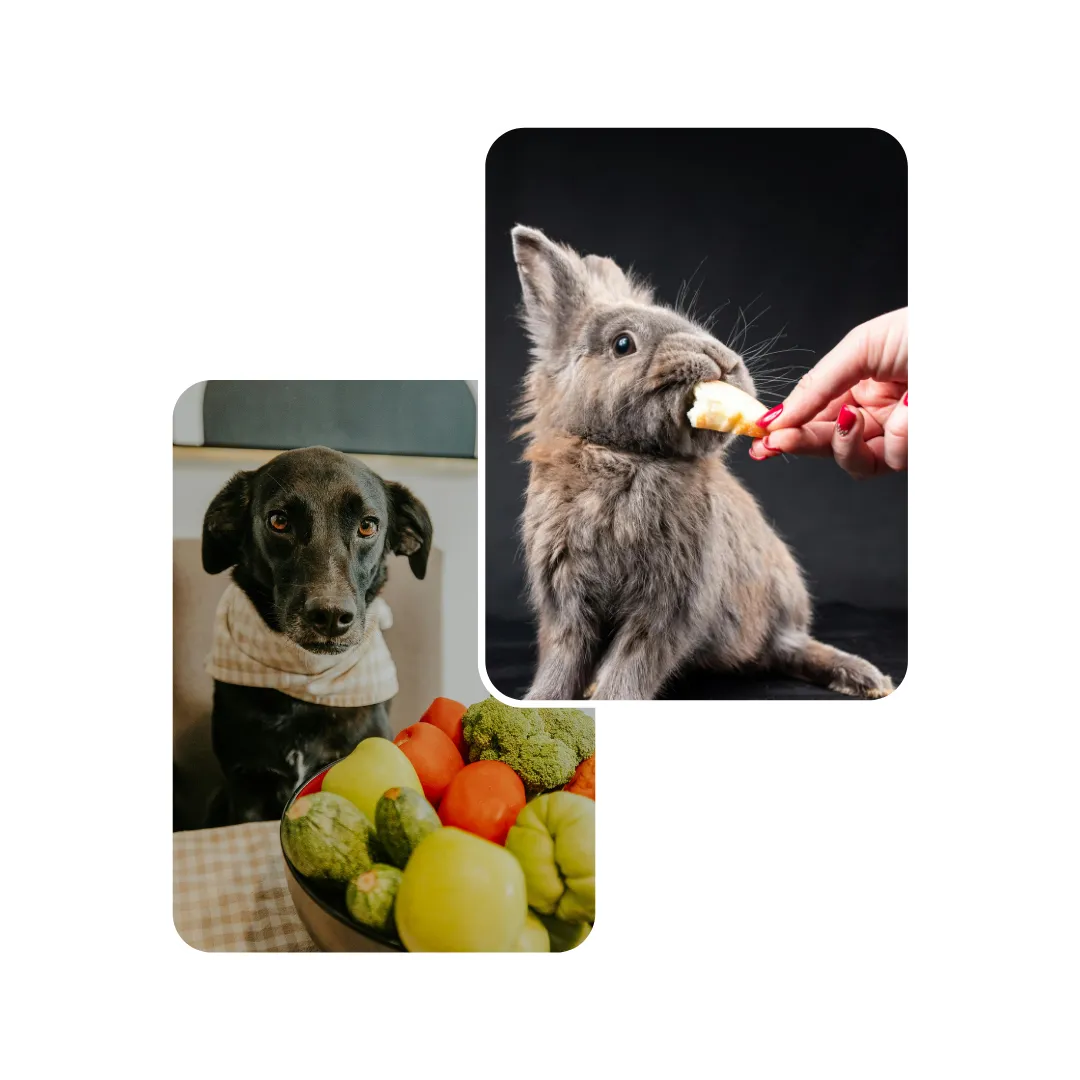
Nutrition is the cornerstone of wellness. Unlike cats and dogs, exotic pets have highly specialized digestive systems that haven't evolved to handle processed or incorrect foods. Getting their diet right is not just beneficial; it's a powerful form of preventative medicine that can stop the majority of common health problems before they ever start.
Grouping animals by their natural diet is the best way to understand their fundamental needs. Feeding an animal outside its guild is a direct path to illness.
Includes: Rabbits, Guinea Pigs, Tortoises, Alpacas
These animals possess digestive systems designed to break down tough, fibrous plant matter. The cornerstone of their diet must be unlimited, high-quality grass hay (like Timothy or Orchard hay). It keeps their gut moving, preventing deadly GI Stasis, and wears down their constantly growing teeth. Pellets should be a tiny portion of their diet, not the main course.
Includes: Leopard Geckos, many Frog species, juvenile Bearded Dragons
For these pets, two concepts are critical: variety and gut-loading. Feeding only one type of insect, like mealworms, leads to severe nutritional deficiencies. Feeder insects must be "gut-loaded"—fed a highly nutritious diet for 24-48 hours before being offered to your pet. This ensures the nutrition is passed on. They must also be dusted with proper supplements.
Includes: Hamsters, adult Bearded Dragons, Sugar Gliders
Omnivores require a carefully managed balance of protein, fats, and plant matter. An improper balance can be disastrous. For example, a diet too high in sugary fruits for a bearded dragon can cause dental issues, while an incorrect calcium-to-phosphorus ratio in a sugar glider's diet is a primary cause of Hind Leg Paralysis, a form of Metabolic Bone Disease.
Includes: Snakes, Cats
Carnivores are built to derive all their nutrients from animal tissue. Snakes require whole prey items (like mice or rats) to get a complete package of calcium from bones, protein from muscle, and vital nutrients from organs. Cats are obligate carnivores and need high levels of specific amino acids like taurine, found only in meat, to prevent serious heart and eye conditions.
Includes: Many small birds like Budgies, Finches, Cockatiels
A diet consisting only of seeds is one of the leading causes of death in pet birds. It is critically deficient in essential vitamins (especially Vitamin A) and calcium, while being excessively high in fat. This leads to obesity, fatty liver disease, and respiratory infections. A healthy diet must be based on formulated pellets, supplemented with fresh vegetables.

Avoiding these common pitfalls is essential for your pet's long-term health.
Many commercially available pet foods, especially the colorful mixes, are filled with low-quality fillers, sugar, and fat. For herbivores like rabbits and guinea pigs, pellets should constitute less than 5% of their diet. The vibrant packaging is designed to appeal to you, the human, not your pet's biological needs. Always prioritize fresh, species-appropriate whole foods.
This is especially vital for reptiles and sugar gliders. Most insects are high in phosphorus and low in calcium. Without proper supplementation (dusting insects with calcium powder) and adequate UVB light for Vitamin D3 synthesis, your pet cannot absorb calcium. This leads to Metabolic Bone Disease (MBD), a painful and deforming condition where the body leaches calcium from the bones, making them soft and brittle. The ideal target is a 2:1 Calcium to Phosphorus ratio.
Your pet's digestive system is not like yours. Foods that are healthy for you can be toxic to them. Onions, garlic, chocolate, avocado, and high-sugar fruits can cause anything from severe digestive upset to organ failure and death. Stick to a diet that is proven to be safe and appropriate for their species. Authoritative sources like the VCA Animal Hospitals offer detailed articles on pet food toxicities.
Follow these steps to become a master of your pet's dietary needs.
This is the golden rule for insectivores. The nutritional value of an insect is determined by what it last ate. "Gut-loading" by feeding insects a high-calcium, nutrient-rich diet for at least 24 hours before feeding them to your pet is non-negotiable.
Learn the specific supplement needs of your pet. For most reptiles, this means dusting insects with a pure calcium powder at most feedings, and a multivitamin/Vitamin D3 powder once or twice a week. Do not guess; follow a schedule recommended by veterinary experts and reputable keepers.
Dehydration is a silent killer. It contributes to kidney disease in mammals, gout in reptiles and birds, and bladder stones in tortoises. Water should be provided in a clean, appropriate dish and changed daily. For species from humid climates, regular misting is also essential.
Nutritional needs are not static; they change with age. A growing juvenile animal will require more protein and calcium than a sedentary adult. Research the specific dietary shifts your pet will need as it matures to prevent obesity and other age-related health issues.
Become a savvy consumer. The first ingredient on any food label should be a high-quality, species-appropriate item (e.g., Timothy Hay for a rabbit, deboned chicken for a cat). Avoid foods where the primary ingredients are corn, wheat, or unnamed "meat by-products." For more expert advice, check out the resources at LafeberVet.
When looking for rumput arnab terbaik, Timothy Hay is the gold standard for adult rabbits due to its excellent balance of fiber, protein, and calcium. Orchard grass and oat hay are also great choices for variety. Alfalfa hay should only be given to young, growing rabbits as it is too rich in calcium and calories for adults.
Wild insects in Malaysia can carry internal parasites that can be passed to your pet. More dangerously, they may have come into contact with pesticides and herbicides from yours or your neighbours' gardens. These chemicals can be toxic and fatal to a sensitive reptile. Always use captive-bred feeder insects from a reliable source.
This depends entirely on the snake's age and size. Hatchling and juvenile snakes need to eat more frequently, typically every 5-7 days. Sub-adults can eat every 10-14 days, while large adult snakes (like pythons) may only eat once every 2-4 weeks. The prey item should be no larger than the thickest part of the snake's body.
For items like cengkerik untuk reptilia Malaysia (crickets for reptiles), many dedicated exotic pet shops in major cities like Kuala Lumpur and Petaling Jaya stock them. There are also numerous online breeders in Malaysia who can ship live crickets, roaches (like Dubia or Red Runners), and superworms directly to you.
To gut-load, place the feeder insects in a separate container with a high-quality commercial cricket diet or a homemade mash of oats, leafy greens (like mustard greens or kale), and a source of moisture like a piece of carrot or potato. Let them feed on this for at least 24 hours before offering them to your pet.
Yes, the common hibiscus flower (bunga raya) is a safe, healthy, and often favorite treat for most herbivorous tortoise species like Sulcatas or Red-Foots. However, you must be 100% certain that the plant and surrounding soil have never been treated with any pesticides or chemical fertilizers.
No, this is extremely dangerous. A common and tragic mistake, a fruit-only diet is severely deficient in protein and has a very poor calcium-to-phosphorus ratio. This will inevitably lead to Metabolic Bone Disease (MBD), causing paralysis, brittle bones, and death. Sugar gliders require a balanced staple diet (like TPG, BML, or Leadbeater's Mix) that includes protein, vitamins, and calcium.